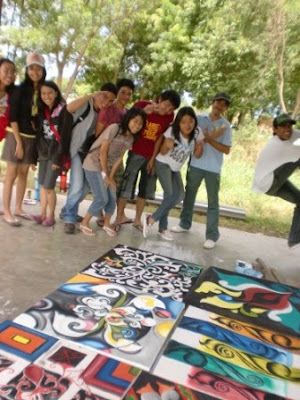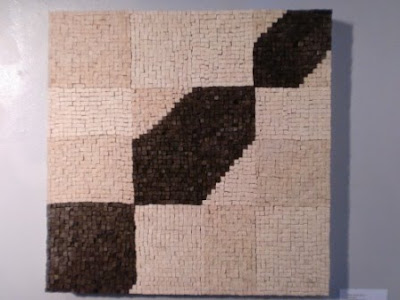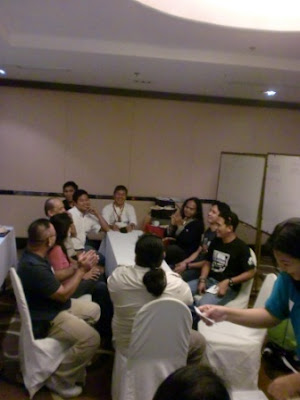























Exhibition of the works Sept 13-18, 2010 Mindanao State University Foundation Anniversary 2010 together with the works of Edrick Aguirre and Julius Seniego-Gensan professional artists

PROJECT TITLE: OKIL & CONTEMPORARY ART:
A DIALOGUE IN ABSTRACTION
A WORKSHOP BY AL-NEZZAR ALI, OKIL VISUAL ARTIST & SCHOLAR
In 1974 the Design Center of the Philippines and the National Museum launched the program “Okir: The Research and Development Committee on the Philippine Ethnographic Arts and Crafts” to answer the need for a total, integrated approach to the study and application of traditional designs that stressed on its importance in terms of their historical and cultural value, as well as their economic potential in their applied forms.
While in 1974, the Design Center of the Philippines and the National Museum launched the program “Okir: The Research and Development Committee on Philippine Ethnographic Arts and Crafts” to answer the need for a total, integrated approach to the study and application of traditional art designs and crafts, this program, which had covered research into 120 Philippine ethnic groups, stressed the importance of these native arts “for their historical and cultural value, as well as their economic potential in their applied forms. Many artists had sought to apply this new form and the trend in ethnic art flourished and many of them advanced the aim of presenting to the urban public through art the cause of the ethnic minorities. But at the end what it showed rather was the disparity in values between the urban and ethnic folk.
This failed attempt was to inspire Abdulmari Imao to fuse the rich legacy of his culture and used okir as theme in his work, thereby producing a modern application of the okir design. His works have subsequently inspired countless others in the pursuit of this technique. As to borrow from his words, that today, okir designs have reached all parts of the world and lives in the modern visual art forms adapted by contemporary Filipino artists. He stressed that to use the design one must ensure the simplicity of adaptation and revitalized studies of the orthodox antique style in modern idiom.
Modern Buildings
Most buildings in Mindanao especially in cities with predominantly Muslim or historically Islamized, have incorporated okir motif in the architectural design of these edifices but mostly as a decorative façade. Some attempted to really incorporate the design to the structure but the resulting design lacks the emotive power of the motif. And most of these designs are just product of impression rather than a thorough study of the design. There is no attempt of the designer to either present the original nuances of the motif or to make it more modern in interpretation. However, there are a few buildings that acquired both the presentation of the antique element of the okir art and its modern manifestation.
Visual Arts
In the visual arts, Imao is the first Moro artist to have used the motif in his exploration of his art. His cubistic styled sarimanok are his first works that brought him into prominence in the Philippine contemporary visual arts. There are non-Moro artists who have experimented in their styles the used of the motif in either in impressionistic or abstract genres. At present, contemporary artists like Saudi Ahmad, Rameer Tawasil and our very own from Gensan, Al-Nezzar Ali, has used extensively their knowledge of okir art into the development of their visual arts by incorporating the design in most of their works.
Ali ‘s used of extensive okil inspired technique is culled from the usual Moro decorative arts or bunya-bunyan, that his paintings are having the same effect of these decorative materials used in festive occasions. As okir designs are ever present on these decorative materials, so as his works, but with contemporary in approach by incorporating figurative images that breaks away with the traditional non-representation of life forms in Muslim art. This style has given another twist to the use of okir art in the modern context putting it once again its value of prominence as a design in art. The okir design on these paintings is decorative in its purpose complementing with the figurative images that evoke a deep meaning and cultural significance.
Therefore, one is then led to the question of why there seems to be much vitality and exuberance in the OKIR artform. An attempt to answer this question will lead us to examine further some aspects of the artistic personality of the Moro people and learn from their contributions. In the process, this recognition might bridge the gap.
PROJECT BACKGROUND
Okir or Okkil (the difference being that Okir is a Maranao pronunciation while Okkil is Maguindanaon), is one of these traditional designs that comes from an old Malayan word that has the same derivative meaning as the Tagalog word "ukit" which means to carve. It refers to carving and consequently as to any type of design prominent among the Moro ethno-linguistic communities.
Imao affirms that okir, or okkir, okkil literally means to carve with the same derivative meaning to the Tagalog word ukit, meaning also is-to carve. Probably in Malayu, the same meaning occurs.
However, in due course, the word is no longer confined to carving and woodwork but became a term suggesting the whole repertoire of local designs and motifs prevalent as artistic production among the Moro people.
From the Indian influences of the prominent naga motif and the stylized bird-like motif up to the Islamic art form where it introduced the elaborate used of flowing flowers and crawling vine designs and the complex geometric patterns, these influences among the local artisans and the impact of the new patterns gave way to the evolution and development of the now known OKIR MOTIF.
‘Okil and Contemporary Art: A Dialogue in Abstraction’ aims to bring to the fore the very nuances of this traditional design and come up with a better understanding of its roots, major influences in the course of its development, its relationship with the community who uses it and its output both traditional and contemporary.
A step-by-step study of the forms and elements of the Okil Art and a survey on its traditional application on objects and material culture will also be explored.
The workshop will establish the okil art legacy as a significant, unique and truly original Mindanao art design that is of great source of inspiration to many artists in the development of their contemporary art styles and techniques in the visual arts.
In the process, it is expected that most of the outputs are into abstraction where a traditional art design can be fused and become the central focal points of art making in a contemporary technique and style.
This style is a dialogue between ancient pattern and the modernist concept of minimalism and abstraction. Abstract art uses a visual language of form, color and line to create a composition which may exist with a degree of independence from visual references in the world Abstract art, nonfigurative art, nonobjective art, and nonrepresentational art are loosely related terms. They are similar, although perhaps not of identical meaning abstraction indicates a departure from reality in depiction of imagery in art. This departure from accurate representation can be only slight, or it can be partial, or it can be complete.
Abstraction exists along a continuum. Even art that aims for verisimilitude of the highest degree can be said to be abstract, at least theoretically, since perfect representation is likely to be exceedingly elusive. Artwork which takes liberties, altering for instance color and form in ways that are conspicuous, can be said to be partially abstract. Total abstraction bears no trace of any reference to anything recognizable. In geometric abstraction, for instance, one is unlikely to find references to naturalistic entities. Figurative art and total abstraction are almost mutually exclusive. But figurative and representational (or realistic) art often contains partial abstraction.
Both Geometric abstraction and Lyrical Abstraction are often totally abstract. Among the very numerous art movements that embody partial abstraction would be for instance fauvism in which color is conspicuously and deliberately altered vis-a-vis reality, and cubism, which blatantly alters the forms of the real life entities depicted.






































